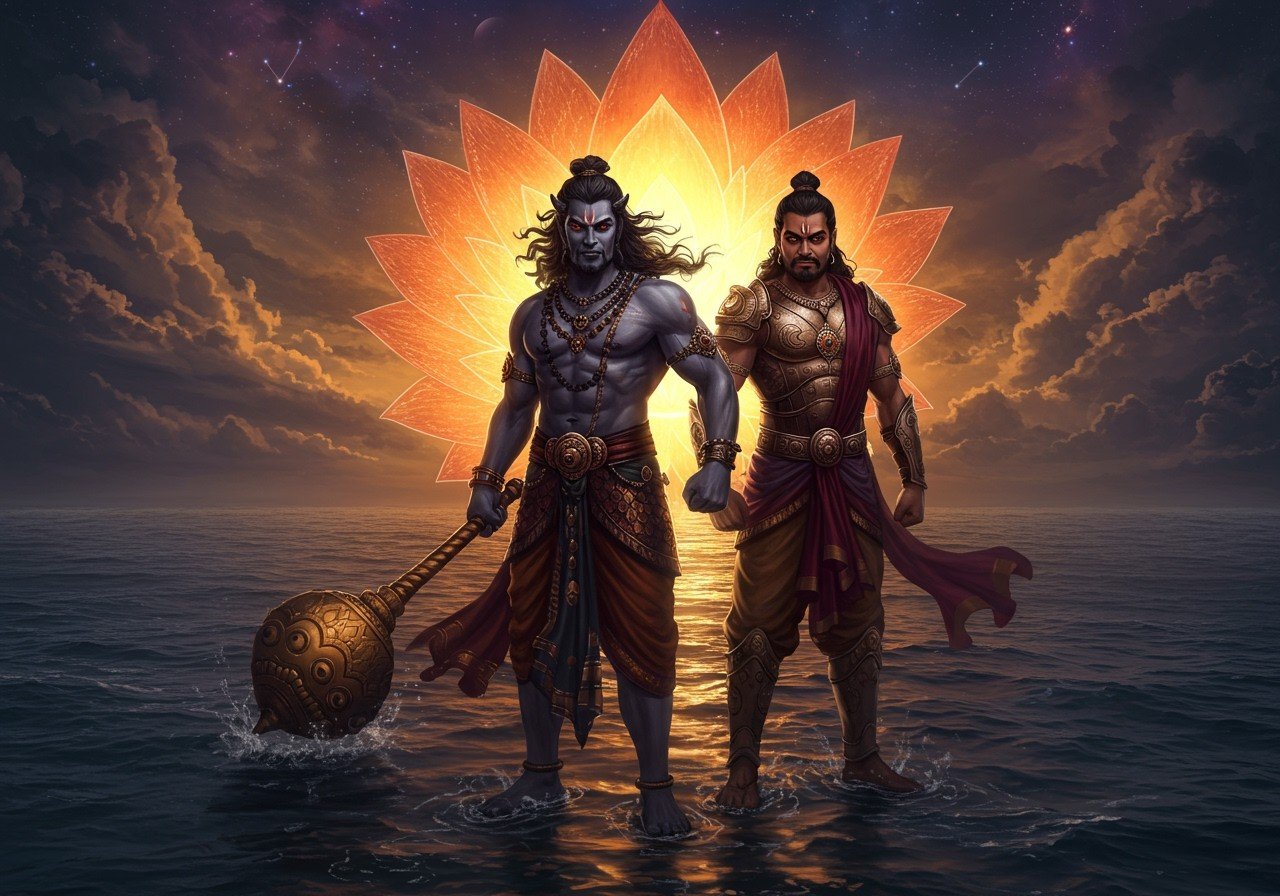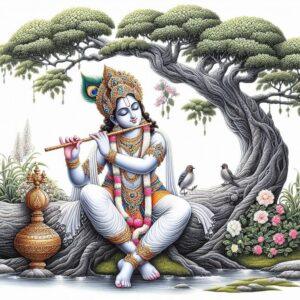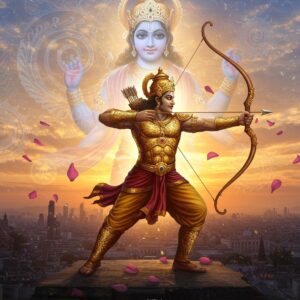
In the vast tapestry of Hindu mythology, the story of Madhu and Kaitabha stands out as a captivating narrative. These two formidable demons, often seen as embodiments of primordial chaos, play a pivotal role in the eternal cosmic dance between order and disorder. Their tale, steeped in symbolism and profound philosophical lessons, continues to resonate with those seeking to understand the complexities of creation and the triumph of good over evil. Let’s delve into this enthralling story and uncover its deeper meanings.
The Birth of Chaos: Origins of Madhu and Kaitabha
The origins of Madhu and Kaitabha are shrouded in mystery, with different versions adding to their mystique. Some scriptures depict them emerging from Lord Vishnu’s earwax during his divine slumber (yoganidra), a symbolic representation of chaos arising from stillness. Other accounts narrate their birth from two dewdrops on a lotus flower sprouting from Vishnu’s navel. One dewdrop, sweet as honey, transformed into Madhu, embodying tamas (darkness or inertia), while the other, hard and unyielding, became Kaitabha, representing rajas (activity or passion). These diverse origins highlight their inherent nature as disruptors of cosmic harmony. Explore the divine forms of Lord Vishnu at poojn.in.
A Cosmic Threat: The Challenge to Brahma
The narrative unfolds with Madhu and Kaitabha posing a grave threat to Lord Brahma, the creator. As Brahma sat upon a lotus, contemplating the creation of the cosmos, these audacious demons stole the sacred Vedas, the very foundation of creation. This audacious act left Brahma powerless, unable to proceed with his divine task. In some versions, the demons’ malevolence extends further, with them directly attacking Brahma, driven by an insatiable desire for conquest and domination.
Divine Intervention: Vishnu’s Awakening
Witnessing this cosmic crisis, Brahma turned to Lord Vishnu for help. His earnest prayers awakened Vishnu from his deep slumber, setting the stage for a monumental battle. This epic clash between Vishnu and the demons raged for five thousand years, a testament to the immense struggle required to restore cosmic equilibrium. In certain tellings, the divine feminine energy takes center stage, with Goddess Mahadevi, Durga, or Yog Nidra playing a crucial role. Brahma’s pleas reach these powerful goddesses, seeking their intervention to awaken Vishnu or to devise a strategy to subdue the formidable asuras. Discover the divine power of Lord Indra, King of Gods, at poojn.in.
Triumph of Wisdom: The Downfall of Madhu and Kaitabha
Unable to defeat the demons through brute force, Vishnu resorted to divine trickery. He lauded Madhu and Kaitabha’s strength, feigning admiration for their prowess, and humbly requested a boon from them. Blinded by arrogance, the demons, in a display of hubris, offered to grant Vishnu a boon instead. Seizing this opportune moment, Vishnu cleverly asked for their own destruction at his hands. Bound by their word, the asuras stipulated a condition – they could only be slain in a place devoid of water, a seemingly impossible feat as the world was then submerged. Undeterred, Vishnu expanded his form, assuming the colossal Vishwa-Roopa or Hayagriva avatar. He lifted the demons onto his thigh, a space above the water-covered earth, and swiftly beheaded them with his Sudarshana Chakra. Deepen your understanding of Japa and its significance at poojn.in.
The Aftermath: Order Restored and Earth’s Formation
With the demise of Madhu and Kaitabha, cosmic order was restored, paving the way for Brahma to resume the creation of the universe. Vishnu, triumphant, earned the epithets Madhusudana (slayer of Madhu) and Kaitabhajit (conqueror of Kaitabha), forever etching his victory in the annals of mythology. From the body fat (medas) of the slain demons, the earth, known as Medini, emerged, symbolizing the birth of a new world from the remnants of chaos. Intriguingly, their bodies fragmented into twelve pieces, an event some interpret as the origin of the Earth’s twelve seismic plates. Delve deeper into the origins of the Ramayana at poojn.in and explore its cultural impact across ages at poojn.in.
Symbolism and Relevance: Timeless Lessons from the Ancient Tale
The story of Madhu and Kaitabha is not merely a tale of divine combat; it’s a repository of profound symbolism and timeless wisdom. The demons’ very existence represents the inherent chaos that lurks beneath the surface of order, while their defeat embodies the power of divine intervention and the triumph of good. This narrative underscores the importance of humility, vigilance against complacency, and the cyclical nature of creation and destruction. For all who seek to navigate life’s complexities, the tale of Madhu and Kaitabha serves as a beacon of hope and resilience, reminding us that even amidst chaos, divine guidance and wisdom can prevail. You can find authentic Sindoor at poojn.in and long cotton wicks for your diya at poojn.in. You can also find beautifully crafted Brass Lakshmi Murti at poojn.in.


